Dr. Fish on the Laboratory Animal Medicine Unit
[section_subtitle]What role does the Laboratory Animal Resources unit, or LAR, have within the CVM?[/section_subtitle]
LAR is an administratively centralized service unit with husbandry, veterinary care, and oversight responsibilities for CVM research and teaching animals. LAR manages facilities in 13 buildings on the CVM campus (approximately 65,000 gross square feet of space) and has a staff of approximately 30, including three veterinarians with academic appointments in the Department of Clinical Sciences. LAR cares for an average census of roughly 5,000 animals, representing more than 20 species.
The mission of LAR is to provide CVM researchers with “optimal animal resources at the least practical cost.” Animal resources means routine housing and husbandry for research and teaching animals, but also animal facilities and equipment; research/teaching animal veterinary care; technical assistance with experimental procedures, handling, and animal transport; instruction in animal handling techniques; animal ordering; assistance with Institutional Animal Care and Use Committee (IACUC) procedures; and consultation on any aspect of laboratory animal medicine or animal model development. LAR has a web site that provides information on policies and procedures for using research and teaching animals at the CVM. http://www.cvm.ncsu.edu/lar/
[section_subtitle]
With the varied responsibilities assigned to LAR, can you describe the background or preparation is necessary for a LAR staff member.
[/section_subtitle]
LAR staff members have a variety of backgrounds, but preferred qualifications for lab animal technicians include a college degree and prior experience in animal care. In both our hiring and new employee training, we emphasize an appreciation for the importance of animals in research, as well as the critical customer service role of the laboratory animal technician in promoting animal welfare and minimizing unwanted experimental variation. New staff training includes preparation for certification by the American Association for Laboratory Animal Science (AALAS), which is now a requirement for all new LAR technicians and supervisors.
[section_subtitle]There are, of course, strict regulations involving the use of animals. What agencies oversee the LAR activity and how does this oversight function?[/section_subtitle]
Research and teaching animal use is governed primarily by two federal regulations: the Animal Welfare Act and the Health Research Extension Act and corresponding Public Health Service Policy on Humane Care and Use of Laboratory Animals. Each of these emphasizes the pivotal role of an Institutional Animal Care and Use Committee appointed by the university’s Chief Executive Officer. The NC State committee is charged with oversight of the university’s use of animals in research and teaching, and has a number of federally mandated functions, including review and approval of animal use protocols, inspection of animal housing facilities, and addressing animal welfare concerns. In addition to this institutional self-regulation, we are subject, under the Animal Welfare Act, to unannounced inspections by veterinary medical officers of the U.S. Department of Agriculture. The CVM also participates in a voluntary accreditation program offered by the Association for the Assessment and Accreditation of Laboratory Animal Care—International, and has been continuously accredited since 1987.
[section_subtitle]What is the process for adopting those animals that assist the CVM in its teaching and/or research mission?[/section_subtitle]
CVM research and teaching animals that have completed their use may, if healthy, be assigned to another project or offered for sale. (The State of North Carolina considers these animals to be surplus property; therefore, adoption is technically considered a negotiated sale, and the price is expected to reflect fair market value.) LAR manages this program, and the process begins by transferring the animals to LAR when their use is completed. There are sometimes strong feelings about the appropriate method of disposition, reflecting legitimate concerns for reducing the overall numbers of animals used in our programs (by appropriate re-use) compared with placing animals in good homes. We encourage the principal investigator on any research project to share with us their thoughts on animal disposition before the project begins.
[section_subtitle]Are there special challenges your team faces in managing the LAR on a daily basis?[/section_subtitle]
LAR faces challenges that are similar in many ways to any operation that cares for animals. These include finding and training personnel who are sensitive to the needs of the animals, the need to provide routine care every day, and assuring appropriate care in emergency situations, such as adverse weather and outages of power, water, or heating/cooling. Our first concern in an emergency is animal welfare, but there is also the special challenge of trying to maintain consistency in environmental conditions for an array of species and experimental needs. The care and use of research/teaching animals is highly regulated, and there is a societal expectation that research facilities are effectively self-regulating. This adds an oversight role to what both IACUC and LAR staff do, and sometimes creates conflict with our customer service goals. Another special challenge that faces research staff as well as LAR employees is the threat of animal rights extremism. We’ve been fortunate at NC State to have had minimal intrusion, but there is an increasingly well-funded and vocal minority who feel that intimidation and even violence are justified to stop the use of animals in research and teaching.
Posted October 29, 2008


